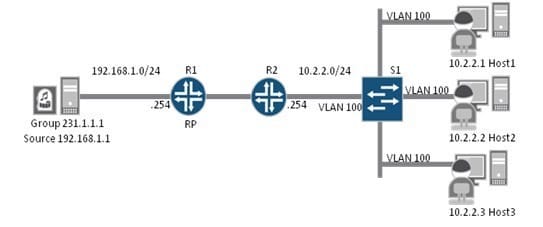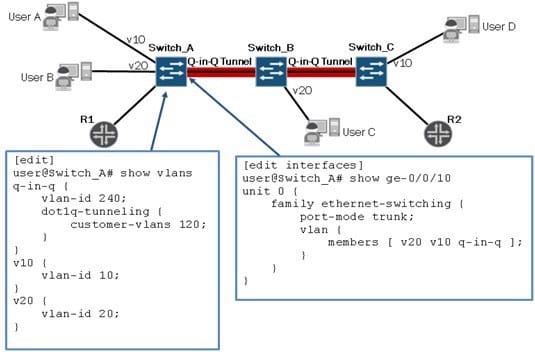Exam Details
Exam Code
:JN0-643Exam Name
:Enterprise Routing and Switching, Professional (JNCIP-ENT)Certification
:Juniper CertificationsVendor
:JuniperTotal Questions
:287 Q&AsLast Updated
:Apr 02, 2025
Juniper Juniper Certifications JN0-643 Questions & Answers
-
Question 111:
-- Exhibit

-- Exhibit -Click the Exhibit button.
In the exhibit, Host2 is the only host currently joining group 231.1.1.1, but S1 is still flooding the traffic to all hosts on VLAN 100.
What feature can be configured on S1 to limit the multicast flooding of traffic to only interested hosts on VLAN 100?
A. Multicast scoping
B. IGMP snooping
C. Multicast VLAN registration
D. IGMP immediate leave
-
Question 112:
-- Exhibit

-- Exhibit -Click the Exhibit button.
You are implementing Q-in-Q tunneling to connect R1 and R2 using the configurations shown in the exhibit.
What must be changed on Switch_A to allow both Dot1q-tunneling VLANs and non-Dot1q- tunneling VLANs on the same trunk interface?
A. Change the Dot1q-tunneling Ethertype to 0x9100.
B. Change the Dot1q-tunneling Ethertype to 0x88a8.
C. Change the Dot1q-tunneling Ethertype to 0x8100.
D. Change the Dot1q-tunneling Ethertype to 0x98a8.
-
Question 113:
-- Exhibit -
user@switch# run show spanning-tree statistics interface ge-0/0/0
STP interface statistics for VLAN 10 Interface BPDUs sent BPDUs received Next BPDU transmission ge-0/0/0.0 170 3 0
STP interface statistics for VLAN 20 Interface BPDUs sent BPDUs received Next BPDU transmission ge-0/0/0.0 171 3 0 -- Exhibit -
Click the Exhibit button.
Based on the exhibit, which spanning-tree protocol is running on ge-0/0/0?
A. VSTP
B. MSTP
C. RSTP
D. PVST
-
Question 114:
-- Exhibit

-- Exhibit -Click the Exhibit button.
Given the topology in the exhibit, which two statements related to the Q-in-Q tunneling implementation are true? (Choose two.)
A. The ge-0/0/0 interface on Provider Bridge A must be configured as an access port.
B. The ge-0/0/0 interface on Provider Bridge A must be configured as a trunk port.
C. Provider Bridge B will make forwarding decisions using a MAC table associated with VLAN ID 100.
D. Provider Bridge B will make forwarding decisions using a MAC table associated with VLAN ID 200.
-
Question 115:
-- Exhibit -
Interface State Area DR ID BDR ID Nbrs em2.0 DR 0.0.0.2 10.94.164.116 10.1.1.1 1 TypE. LAN, Address: 11.1.1.2, Mask: 255.255.255.252, MTU: 1500, Cost: 1 DR addr: 11.1.1.2, BDR addr: 11.1.1.1, Priority: 128 Adj count: 1 Hello: 10, DeaD. 40, ReXmit: 5, Stub Auth typE. None Protection typE. None Topology default (ID 0) -> Cost: 1 -- Exhibit -
Click the Exhibit button.
Referring to the exhibit, which statement is true?
A. The OSPF cost of the interface is 128.
B. The authentication type of the area is MD5.
C. This interface is part of a stub area.
D. This router is the BDR.
-
Question 116:
-- Exhibit -
20.0.0.0/8 *[BGP/170] 01:10:38, localpref 100, from 10.0.0.1 AS path: 100 I > to 15.0.0.2 via ge-0/0/0.0 [BGP/170] 00:00:59, localpref 100 AS path: 100 ? > to 35.0.0.2 via ge-0/0/1.0 -- Exhibit -
Click the Exhibit button.
Referring to the output in the exhibit, why does the router prefer the path toward interface ge- 0/0/0.0 for the 20.0.0.0/8 route?
A. The origin is IGP.
B. The origin is unknown.
C. The AS path is longer.
D. Multihop is enabled.
-
Question 117:
-- Exhibit

-- Exhibit -
Click the Exhibit button.
In the exhibit, customers connected to Area 3 must have access to external prefixes received from the data center connected to the router in Area 1. These configurations are currently applied to the routers in Area
1:
{master:0}[edit]
user@Area-1-ABR# show protocols ospf
no-nssa-abr;
area 0.0.0.1 {
nssa;
interface ge-1/1/1.100;
}
{master:0}[edit]
user@Area-1-External# show protocols ospf
area 0.0.0.1 {
stub no-summaries;
interface ge-1/1/1.100;
}
What must you change for these configurations to work?
A. Configure the ABR router in Area 1 to support a virtual link.
B. Delete no-summary-lsa from the ABR router in Area 1.
C. Configure the external router in Area 1 for NSSA.
D. Configure the ABR in Area 1 for a default LSA with a default-metric of 10 and no- summaries.
-
Question 118:
-- Exhibit -
user@R1> show configuration protocols pim rp
local {
address 192.168.3.1;
}
auto-rp discovery;
static {
address 192.168.5.1;
}
user@R1> show route 192.168.0.0/16
inet.0: 18 destinations, 21 routes (18 active, 0 holddown, 0 hidden) + = Active Route, - = Last Active, * = Both
192.168.2.1/32 *[Direct/0] 3w4d 04:58:14
> via lo0.0
192.168.5.1/32 *[OSPF/10] 00:52:25, metric 1
> via lt-0/0/0.0
192.168.10.1/32 *[OSPF/10] 00:48:06, metric 1
> via lt-0/0/0.2
192.168.50.1/32 *[OSPF/10] 00:48:06, metric 1
> via lt-0/0/0.4
-- Exhibit -
Click the Exhibit button.
Router R1 in the exhibit is receiving auto-RP announce messages specifying an RP of 192.168.10.1 and BSR messages specifying an RP-set with an RP of 192.168.50.1.
Which address will R1 use as the RP for traffic destined to the 224.1.1.1 multicast group?
A. 192.168.3.1
B. 192.168.5.1
C. 192.168.10.1
D. 192.168.50.1
-
Question 119:
An OSPF router is an ABR but not an ASBR.
Which three types of LSAs would you expect this router to generate? (Choose three.)
A. Type 1 LSA
B. Type 3 LSA
C. Type 4 LSA
D. Type 5 LSA
E. Type 6 LSA
-
Question 120:
You are configuring BGP peering with a neighboring AS. Multiple physical links exist between your edge router and the neighboring edge router, and you want a configuration that supports the highest degree of redundancy.
How can you implement this scenario?
A. Configure multiple peerings between the routers' physical interfaces.
B. Use the multipath feature.
C. Configure multiple peerings between the routers' logical interfaces.
D. Use the multihop feature.
Related Exams:
JN0-102
Internet Associate, Junos(JNCIA-Junos)JN0-104
Junos, Associate (JNCIA-Junos)JN0-105
Junos, Associate (JNCIA-Junos)JN0-1101
Juniper Networks Certified Design Associate (JNCDA)JN0-130
Juniper networks Certified internet specialist.e(jncis-e)JN0-1301
Data Center Design, Specialist (JNCDS-DC)JN0-1302
Data Center Design Specialist (JNCDS-DC)JN0-1331
Security Design, Specialist (JNCDS-SEC)JN0-1332
Security Design, Specialist (JNCDS-SEC)JN0-1361
Service Provider Design Specialist (JNCDS-SP)
Tips on How to Prepare for the Exams
Nowadays, the certification exams become more and more important and required by more and more enterprises when applying for a job. But how to prepare for the exam effectively? How to prepare for the exam in a short time with less efforts? How to get a ideal result and how to find the most reliable resources? Here on Vcedump.com, you will find all the answers. Vcedump.com provide not only Juniper exam questions, answers and explanations but also complete assistance on your exam preparation and certification application. If you are confused on your JN0-643 exam preparations and Juniper certification application, do not hesitate to visit our Vcedump.com to find your solutions here.